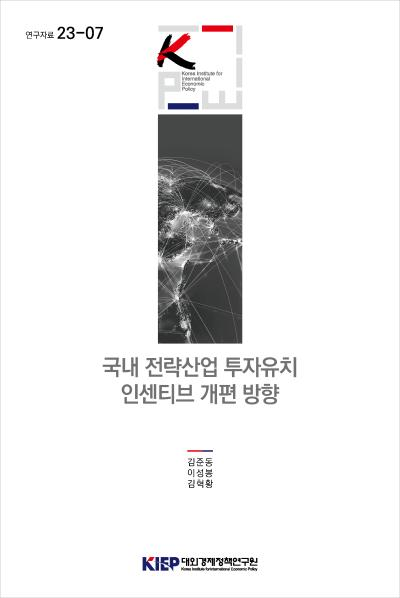Policy Reference
Publications
Policy Reference
To list

Reforming Incentive Policies to Increase FDI in Korea’s Strategic Industries
subsidy, foreign direct investment
Author June Dong Kim, Seong-Bong Lee, and Hyuck-Hwang Kim Series 23-07 Language Korean Date 2023.12.08
Foreign direct investment(FDI) in Korea remains at a lower level compared to that of major countries, although the amount of FDI in Korea in 2022 on notification basis exceeded 30 billion USD for the first time in history. And major advanced countries have recently expanded investment incentives to strategic industries such as semiconductors and secondary batteries. Therefore, we need to make a landmark transformation of our FDI incentive policies. In this regard, this study first took a look at the recent trends of FDI in Korea and reviewed the incentive systems for attracting strategic investment in major countries such as the U.S., the EU, Japan, and China. And then it attempted to present policy directions for reforming incentive systems to attract strategic investment to Korea. In particular, it aimed to present the improvement of the cash incentive system as well as the use of specialized complexes for advanced industries and specialized zones for equal opportunity development.
First, by looking at the recent trends of FDI into Korea (2010~2022), there are more FDI from advanced countries and tax haven countries such as U.S.A., Japan, Singapore, Malta, Netherland than from others. Also, we found more FDI in services industry than in manufacturing industry. Finally, there were more greenfield FDI than M&As.
Next, we investigated recent incentive systems to attract investment in strategic industries in some key countries. These include the CHIPS and Science Act along with the Inflation Reduction Act of the U.S., and the European New Investment Strategy, InvestEU Program, and European Chips Act in the EU. We also analyzed Japan’s Direct Investment Promotion Strategy toward Japan, Promotion Act of 5G, Semiconductor Fund, and Green Innovation Fund, as well as China’s FDI expansion policy in the manufacturing sector. From this investigation, we confirmed that major countries (ⅰ) operate investment incentive systems without any discrimination between foreign and domestic firms, (ⅱ) provide large amounts of investment subsidies, and (ⅲ) have formed a social consensus that large-scale assistance is necessary to attract investment in strategic industries.
Based on these characteristics in major countries, we presented the improvement of cash assistance system as well as the use of specialized complexes for cutting-edge industries and equal opportunity development special zones as policy directions for reforming incentives to attract investment in domestic strategic industries. More specifically, in the case of improving the cash subsidy system, we found that the following measures are necessary; (ⅰ) increasing the budget available for cash subsidies, (ⅱ) increasing the R&D subsidy expenditures in the aspect of software, (ⅲ) and calculating the amount for cash assistance taking into account the quality of employment, not to mention the effect of job creation. Finally, we presented a plan for linking specialized complexes for cutting-edge industries and special zones for equal opportunity development in order to provide unprecedented support for the large-scale investments in strategic industries.
Sales Info
| Quantity/Size | 79 |
|---|---|
| Sale Price | 5 $ |
 공공저작물 자유이용허락 표시기준 (공공누리, KOGL) 제4유형
공공저작물 자유이용허락 표시기준 (공공누리, KOGL) 제4유형
대외경제정책연구원의 본 공공저작물은 "공공누리 제4유형 : 출처표시 + 상업적 금지 + 변경금지” 조건에 따라 이용할 수 있습니다. 저작권정책 참조
